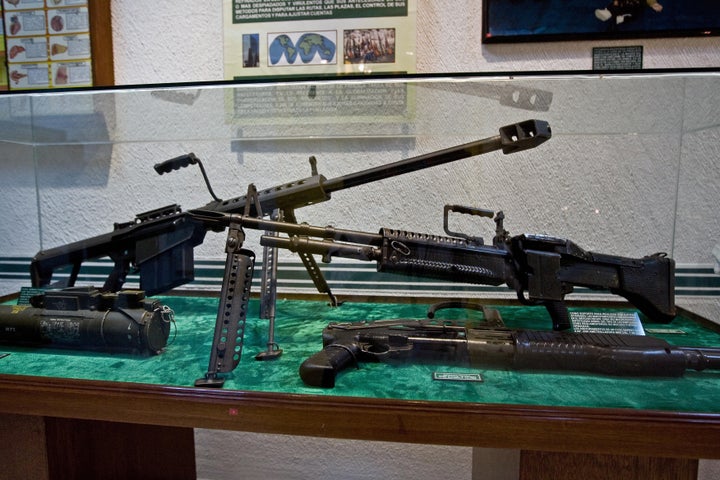
In a recent "commentary" posted on CNN.com, National Rifle Association Executive Vice President Wayne LaPierre dismissed statements from U.S. and Mexican government officials that, based on firearms tracing data from the federal Bureau of Alcohol, Tobacco, Firearms and Explosives (ATF), Mexico's drug cartels obtain 90 percent or more of their firearms from the United States.
In making his argument, LaPierre preaches to the choir in the apocalyptic tones familiar to anyone with even a passing acquaintance with the gun group's rhetoric: "gun abolitionists claim Mexican gun laws are so strict that our 'weak laws' (read: freedoms) are to blame for 'fueling the violence' in Mexico."
He then offers a series of unverifiable statements that define the term "argument by assertion." LaPierre's goal? To draw an opaque curtain across facts that have been repeatedly stated by both U.S. and Mexican government officials. He writes:
Well, to believe that...You have to believe that Mexico's drug cartels, which possess the wealth and armies of nations, prefer American semiauto target and hunting rifles over fully automatic machine guns and any other military arms they want to crush opposition.
You have to believe Mexican drug lords―who make Forbes magazine's list of billionaires―don't get large lots of weaponry on the transnational black market but instead choose to trifle with paperwork at U.S. gun stores...
Well, believe it Wayne. Illegal gun traffickers are more than happy to "trifle with paperwork at U.S. gun stores." A new study released today by my organization, the Violence Policy Center, looks at U.S. court records from southwestern states and clearly shows that illegal gun traffickers involved in smuggling firearms to Mexico seek semiautomatic assault weapons, armor-piercing handguns, and 50 caliber anti-armor sniper rifles from U.S. gun shops. Many of these guns are imported, underscoring the urgent need for the Obama Administration to use its executive powers to strictly enforce existing restrictions on the import of such non-sporting weapons--a ban (separate from the now-expired 1994 federal assault weapons ban) first imposed by the George H.W. Bush Administration, tightened up by the Clinton Administration, and left in ruins by the George W. Bush Administration. Where the Obama Administration will stand on this issue--which they could address today without Congressional action--remains to be seen. Of course, this is a case of "enforcing the gun laws on the books" that the NRA would rather ignore.
For the report, the Violence Policy Center worked to identify criminal cases alleging illegal gun trafficking to Mexico filed in U.S. federal courts in Arizona, California, Nevada, and Texas for the period February 2006 to February 2009. Reviewing government press releases, government statements, and local news coverage, the VPC was able to identify and obtain the court documents for 21 cases filed during this period. The information presented in the report regarding specific firearms was retrieved exclusively from facts specified by the United States government, primarily in criminal complaints and indictments. The VPC included every case it found, regardless of the type or number of weapons trafficked.
Looking at the set of guns specifically named in the documents, the study found:
o Traffickers seek out semiautomatic assault weapons (42 percent of guns named), armor-piercing handguns capable of penetrating the body armor worn by law enforcement (18 percent), and 50 caliber anti-armor sniper rifles (two percent). All of the armor-piercing handguns were FN Herstal Five-seveN pistols, known as the mata policia, or "cop killer" in Mexico.
o More than 90 percent of the 226 rifles named could be identified as semiautomatic assault rifles, primarily AK-47 and AR-15 variants.
o More than one-third of the guns obtained by traffickers were made by foreign manufacturers. o At least 70,000 rounds of ammunition were directly involved in the cases.
So much for "trifling." But to the NRA, the best defense is an incendiary offense. How else can you defend military-bred guns used to kill law enforcement and public officials? Yet the NRA 's unsubstantiated claims--and let's remember, this is the organization that for years paid a spy to infiltrate the gun violence prevention movement, befriending the victims of gun violence for NRA money (but I'm sure they're trustworthy)--are allowed to gain a toehold because of the information vacuum created by a federal measure backed by the organization known as the Tiahrt Amendment. Up until 2003, comprehensive crime gun trace data was available under the Freedom of Information Act (FOIA). This all changed with the Tiahrt Amendment (named after its sponsor, Kansas Representative Todd Tiahrt), a spending prohibition that bans the federal Bureau of Alcohol, Tobacco, Firearms and Explosives from releasing such information. Now, we don't even know the top crime gun in America. Bad for public safety. Good for the NRA, gunmakers, and criminals. Right now a battle is being fought to repeal the measure--an action endorsed by President Obama during the campaign.
So why are "Mexican drug lords who make Forbes magazine's list of billionaires" shopping in the U.S.A. Because they know a bargain when they see one.
